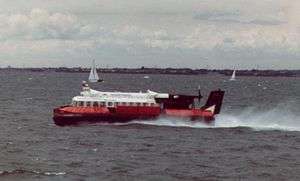SR.N6
 SR.N6 of Hovertravel on the Solent, 1982 | |
| Class overview | |
|---|---|
| Name: | SR.N6 Winchester class |
| Builders: | British Hovercraft Corporation |
| Preceded by: | SR.N5 |
| General characteristics | |
| Type: | hovercraft |
| Displacement: | 10.9 tons |
| Length: | 17.78 m (58 ft 4 in) |
| Beam: | 7.97 m (26 ft 2 in) |
| Height: | 6.32 m (20 ft 9 in) on cushion |
| Propulsion: | 1 Rolls-Royce Gnome turbine engines 1,050 hp (780 kW) for lift and propulsion driving single four-bladed variable-pitch propeller |
| Speed: | 50 kn (93 km/h) |
| Range: | 170 miles at 30 knots |
| Capacity: | 58 seated passengers |
| Crew: | 3 |
The Saunders-Roe (later British Hovercraft Corporation) SR.N6 hovercraft (also known as the Winchester class) was a larger version of the earlier SR.N5 series. It incorporated several features that resulted in it quickly becoming the most produced and successful hovercraft design in the world. Compared to the SR.N5, the SR.N6 Mk.1 was stretched in length, with over double the seating capacity.
While the SR.N2 and SR.N5s operated in commercial service as trials craft, the SR.N6 was the first production craft to enter commercial service. Experience with the design would lead to the very large automobile ferry SR.N4, which is no longer in service.
Configuration
After initial trials the prototype was operated by Scandinavian Hovercraft Promotions of Oslo, Norway under the name 'Scanhover'. It entered service in June 1965 and it was later joined by 011. They operated on a 120-mile route, with six stopping points, in the Ålesund area. These craft were later operated between Aarhus and Kalundborg in Denmark and in February and March 1966 also successfully underwent cold weather trials in Sweden, in the Gulf of Bothnia.
The increase length of the SR.N6 allowed it to accommodate 38 passengers instead of the 18 carried by the SR.N5. It was subsequently extended again to accommodate a further 20 passengers. This made SR.N6 commercial operations much more viable than any previous hovercraft design. By eventually increasing the capacity to 58 seats the Mk.1S became the first hovercraft capable of transporting a typical coach load of people.
Military use
Military variants have seen service with the Italian Navy, Egyptian Navy, Iraqi Navy (Mk 6C), Iranian Navy and the Saudi Arabian Frontier Force.
Civilian use
P & A Campbell used SR.N6-024 to promote their Townsend Car Ferries service in 1966 and 1967, touring various holiday resorts in Great Britain offering pleasure rides.

In 1998 the Canadian Coast Guard decommissioned its last SR.N6 that was in active service, commissioned as CCGH 045.
Survivors
The original prototype SR.N6 Mk.1 (009) is currently on display at the Hovercraft Museum in Lee-on-the-Solent, Hampshire, England. With 22,000 hours of service over a 20-year period it is the world's most extensively operated hovercraft. The museum has several other SR.N6 on display or in various states of restoration. One is operational and occasionally used for demonstrations.
Capacity
(Military configuration) The SR.N6 class is capable of carrying 55 fully equipped troops, or 6 tons of equipment.
Toys
The SR.N6 has been the subject of two popular toy versions. A small metal replica was produced for over twenty years by Matchbox Toys, while a much larger die-cast version was produced in the 1970s by Dinky Toys. A 12.7 cm model was released by Matchbox in 1974 as part of their Super Kings range.[1]
Specifications
- SR.N6 Mk. 1S Winchester Class - SR.N6 Mk 8 (in production)
- Designer / Manufacturer: Saunders-Roe, (later British Hovercraft Corporation)
- Crew 3
- Dimensions
- Length 17.78 metres
- Width 7.97 metres
- Height (on cushion) 6.32 meters
- full load displacement 10.9 tons
- Propulsion
- Motor: gas turbine engine
- Power: 1 Rolls-Royce Gnome turbine engine 1,050 horsepower for lift and propulsion
- Propellers: 1 four-bladed Dowty Rotol variable-pitch propeller
- Performance
- Speed 50 knots
- Range 170 miles at 30 knots
- Military Lift: 55 fully equipped troops or 6 tons of equipment
- Weapons
- Either a ring-mounted machine gun (0.5in or 7.62 mm) or short range wire guided surface-to-surface missiles mounted on the side decks.
External links
References
- ↑ Kevin McGimpsey & Stewart Orr, Collecting Matchbox Diecast Toys, The First Forty Years, page 232.
- Hovercraft Museum: SR.N6 Technical Information
- Hovercraft Museum: Craft Built
- Saunders, Stephen (RN) Jane's Fighting Ships 2003-2004 ISBN 0-7106-2546-4